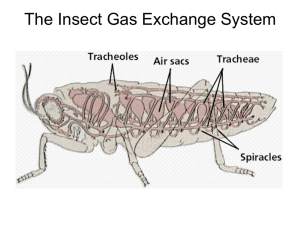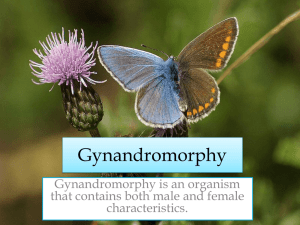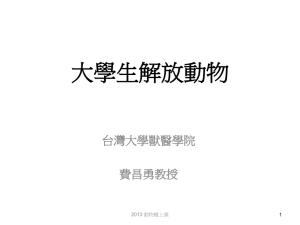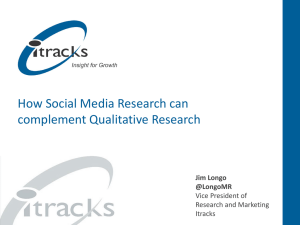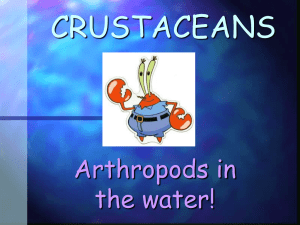Report Introduction
advertisement
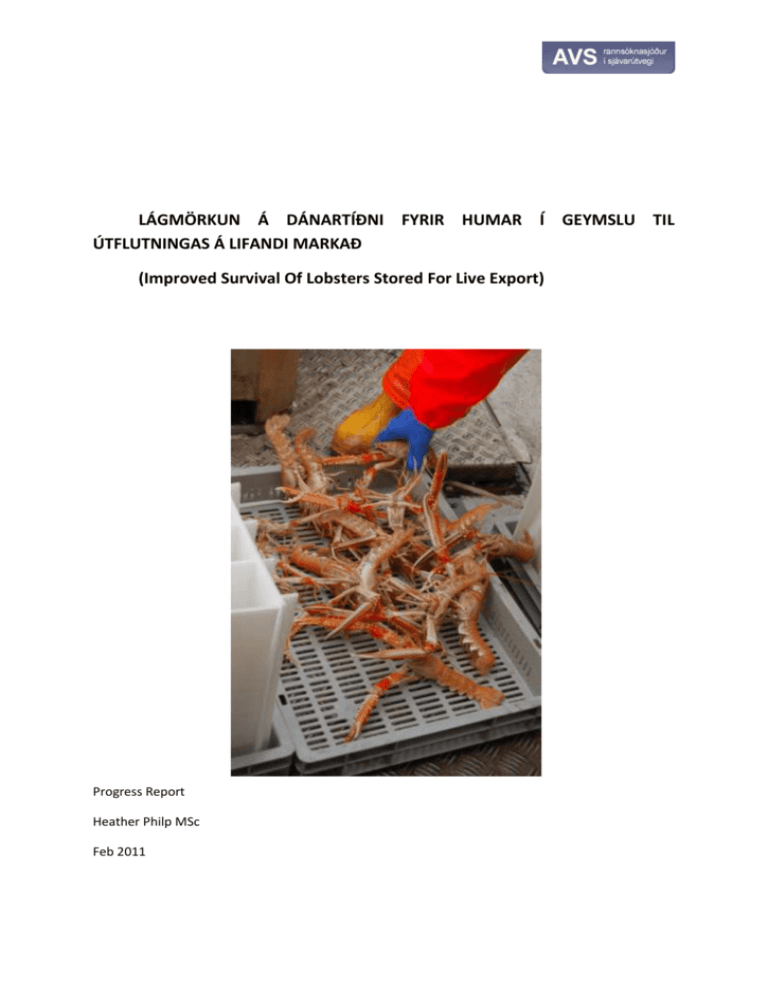
LÁGMÖRKUN Á DÁNARTÍÐNI FYRIR HUMAR Í GEYMSLU TIL ÚTFLUTNINGAS Á LIFANDI MARKAÐ (Improved Survival Of Lobsters Stored For Live Export) Progress Report Heather Philp MSc Feb 2011 Contents Summary ............................................................................................................................................. 3 Report Introduction ............................................................................................................................ 3 Task 1 – Define the relationship between nutritional parameters and concentration of circulating protein................................................................................................................................................. 4 Introduction ........................................................................................................................................ 4 Methods & materials .......................................................................................................................... 4 Results ................................................................................................................................................. 6 Haemolymph Protein .......................................................................................................................... 7 Lobster weight..................................................................................................................................... 9 Hepatopancreas proximate composition .......................................................................................... 12 Discussion.......................................................................................................................................... 14 Conclusion & Future Direction .......................................................................................................... 15 Task 2 - Determine maximum storage time based on nutritional status ......................................... 15 Introduction ...................................................................................................................................... 15 Methods & materials ........................................................................................................................ 15 Results ............................................................................................................................................... 16 Discussion.......................................................................................................................................... 16 Future direction ................................................................................................................................. 16 Task 3 - Determine effects of nutritional status on transport survival rates.................................... 16 Introduction ...................................................................................................................................... 16 Methods & materials ........................................................................................................................ 17 Results ............................................................................................................................................... 17 Discussion.......................................................................................................................................... 17 Future direction ................................................................................................................................. 17 Report Conclusions ........................................................................................................................... 18 References ........................................................................................................................................ 18 Summary All three of the experimental work packages have been started with WP1 being completed and WP2&3 are being halfway through. The preliminary results indicate that the strongest motivator of changes in haemolymph protein concentration is the moult cycle. This is very interesting since it is the first time such a relationship has been found in clawed lobsters and one of the few studies to determine this in crustaceans. Further, it appears that mobilisation of energy reserves during starvation begins with carbohydrate, then lipid and finally protein. This is also a new discovery for both this species and clawed lobsters in general. Samples are still being processed and when this has been completed a comprehensive analysis of the data will be carried out in order to complete WP4, a protocol for management of stored lobster stock in order to maximise survival. To date, survival of experimental animals up to four months has been good Report Introduction The aim of this project is to investigate the effect of extended storage on lobsters destined for live export. Previous work determined that for lobsters to be maintained in good health past two weeks, a closed system that re-circulated filtered water was necessary. However, during the course of the experiments, it was also found that up to one third of animals stored longer than three weeks died despite showing no obvious evidence of disease (unpublished data). It was theorised that nutritional status could be the reason for this high level of mortality. In the American lobster industry, some companies test the blood protein level of animals upon intake as a measure of their physiological condition. Typically, a hand-held refractometer is used: a small drop of haemolymph is removed with a needle & syringe and placed upon the optical surface. When the instrument is directed towards a source of light, a system of lenses and prisms within cause the light to refract and a shadow line is cast upon the reticle where a scale allows a reading to be taken. Whilst mildly invasive, this non-lethal approach has facilitated improved management of stock and reduced mortalities during storage and transport. Little research has been directed towards this aspect of crustacean health and condition in Nephrops although there is a rapidly expanding live industry for the species. The main reason for this is that to date, animals are usually sold and transported within a few weeks of capture. However, in Iceland access to the fishery is very weather-dependant with boats potentially being prevented from fishing for weeks at a time, especially in winter. This risks a situation where producers are only able to supply the market during the summer months when prices are depressed and miss the opportunity to sell during the winter when product value can be three times this. We intend to evaluate the use of haemolymph refractometry as a means to assess the condition of lobsters. Further, we will explore the effect of extended storage on live lobsters in terms of mortality, taste and capacity to survive the stress of transport. The first part of the project focuses on identifying the relationship between haemolymph protein and other measures of condition including hepatopancreas stores of lipid, protein and glycogen, muscle protein and haemocyanin. Following this, a series of experiments will be carried out where animals stored for progressively longer periods of time are subjected to simulated transport covering a range of times. The project has been divided into four tasks of which the first three involve data collection and experimentation. The final task comprises report writing and the publication of results. This mid- project report summarises the developments in the research so far. The task titles have been used as chapter headings under which a full description of the work carried out and findings made is given. Task 1 – Define the relationship between nutritional parameters and concentration of circulating protein Introduction The life history of crustaceans is more complex than most vertebrates because the hard exoskeleton must regularly be shed and replaced with a new larger one; around these moments of ecdysis, foraging stops completely for extended periods of time. Further, the environment that many marine crustaceans inhabit is subject to great variation in food availability. Consequently, within the natural environment animals such as lobsters are exposed to, and are physiologically tolerant of, periods of starvation. This feature has been exploited by processors who catch, store and transport the animals, all without feeding. During two to three weeks storage period typical for Nephrops, a very small weight loss occurs which is measurable in grams and unlikely to affect the sale price. However, the mobilisation of reserves is a finite process after which the animal may either die or be sufficiently weakened as to not survive the stress of transportation to the market. Several species have been subjected to controlled starvation in order to elucidate the mechanisms of reserve mobilisation. Interestingly, a variety of responses have been observed which are not only species-specific but developmental stage-specific. For example, Spiny lobster larvae were found to catabolise more lipids than carbohydrates and proteins in stages II, IV and VI than other stages (Ritar et al., 2003). Early work on Nephrops by Dall (1981) focused on lipid storage and metabolism where it was found that the hepatopancreas formed the main storage site. Lipids levels did not decrease in 5 weeks of storage, indicating that another source of energy was being utilised preferentially. Baden et al (1994) found that hepatopancreas glycogen reduced to 3% of the original value in Nephrops starved for 7 months. Finally, a recent study by Mente (2010) compared protein metabolism and free amino acid accumulation between two different diets in cultured Nephrops. The current study represents the first dedicated investigation into the metabolism of storage reserves in the species Nephrops norvegicus. Further, the aim is to determine the relationship between the nutritional parameters and the concentration of haemolymph protein. This approach was first utilised by Stewart in 1967 who proposed that lobster haemolymph protein levels directly relate to their diet. A decade later, Leavitt & Bayer (1977) used a hand-held refractometer to measure protein in lobster haemolymph in the field. Since then, the practice has been almost universally adopted by the American lobster industry as a means to quickly and easily measure vitality (Ozbay & Riley, 2002). Methods & materials The initial months of the project were spent preparing the facilities and acquiring the necessary equipment. The vessel intended for use, the Hafro boat Fredrik Jesson, required a series of modifications including the addition of a new winch arm to enable the lobster traps to be hauled from the side rather than the back. The filtration system which cleans and circulates the water in the onshore storage tanks needed replacement parts from the UK to ensure its effective operation for the duration of the project. During September and October 2010, several fishing trips were undertaken in which male lobsters with a carapace length between 50 and 65 mm were selected for use in the study (Figure 1). 180 animals were randomly chosen to be used in Task 1 and arbitrarily allocated to one of 9 groups of 20 (8 weeks storage + one control group). The carapace length of each individual was recorded along with weight, moult stage and any other noticeable characteristics (for example shell hardness, claw damage). A haemolymph sample of 1ml was drawn and the protein level measured by refractometer (Figure 2). The remaining haemolymph (approximately 0.8ml) was frozen in a labelled eppendorf for later haemocyanin analysis. The lobster was placed into a pre-marked ‘tube’ in 40-space crate which when full was placed to the storage tank. Figures 1-3: Catching the lobsters (top), using the refractometer to measure haemolymph protein (centre) and the crates in which the lobsters are stored for the duration of the experiment (bottom). Starting at a storage time of 0 Weeks, one group per week were removed and a full spectrum of analyses performed on each individual. The weight of the animal was recorded and a large sample (2-3ml) of haemolymph drawn. A small drop was placed on the optical surface of the refractometer and the protein level recorded. The remainder was divided between two eppendorfs for subsequent haemocyanin and total protein analysis. The lobster head was separated from the body and the exposed hepatopancreas removed and weighed after being blotted dry. Both the hepatopancreas and tail were placed in pre-marked ziplock bags and frozen to be analysed later. In the laboratory, the hepatopancreas was divided into three parts for lipid, protein and carbohydrate analysis. All sections were dried to a constant weight and the water content calculated. The lipid extraction was performed using the petroleum ether method; briefly, ether was passed through the sample using distillation equipment which moved only the lipid portion from the sample. Protein analysis followed the Kjeldahl method which uses the amount of reduced nitrogen liberated from the sample by heating with sulphuric acid to calculate the protein content of the sample. Glycogen concentration within the sample was measured using anthrone reagent which turns from yellow to blue-green when heated in the presence of sugars. The colour change was measured spectrophotometrically and compared against a calibration curve prepared using glucose as a standard. Haemocyanin was measured using the method of Baden et al (2003): the defrosted sample was oxygenated by the addition of distilled water and the absorbance measured at 335nm by spectrophotometer. The extinction coefficient of Nickerson & Holte (1971) was used to calculate the concentration of haemocyanin. Disposable cuvettes with a 1cm pathlength and 1.5ml maximum capacity were used throughout the study. Haemocyanin concentration 1 (measured upon intake) has been analysed but Haemocyanin 2 (taken when animal was sacrificed) is still outstanding. Analysis of the lipid and protein content was completed as far as Week 7 (from 8 weeks) whilst carbohydrate testing was completed as far as Week 2. Results Haemolymph Protein Haemolymph protein concentration was highly variable ranging between 3.4 and 16 g/dl with no discernable pattern across the size classes measured (Figures 4 & 5). However, the histogram indicated that whilst most of the data followed an approximately normal distribution, a separate peak at very low protein levels (less than 5 g/dl) was present. When moult cycle stage was introduced as an independent variable, a strong correlation was detected (Figure 6). The difference between the haemolymph concentration upon intake and at the point of sacrifice increased as storage time increased (Figure 7), which was statistically significant between weeks 4 & 5, and 5 & all subsequent weeks ( χ28= 109.362; p<0.005). In the first week of storage, reduction in concentration was found predominantly in the lobsters with the highest intake concentration, i.e. those at the most advanced stage in the moult cycle (Figure 8). However, as the experiment progressed the reduction was found across all other intake concentrations too and this pattern was not detected again. Figure 4. Histogram of haemolymph protein concentration measured upon intake Figure 5. Haemolymph protein concentration plotted against carapace length Figure 6. Protein concentration grouped by moult stage Figure 7. Difference between intake and final haemolymph protein concentration Protein (final) - Protein (intake) 3.5 3.0 2.5 2.0 1.5 1.0 0.5 0.0 5.0 7.0 9.0 11.0 13.0 15.0 Haemolymph protein concentration (g/dl) Figure 8. Difference between final and initial protein concentration against intake protein concentration. Lobster weight During the first week, a small amount of weight was lost from most of the lobsters (Figure 9). Interestingly, during the second week of storage many animals were found to have actually gained weight relative to their intake measurement (Figure 10). However, by the third week a decrease was observed and although it appeared that the weight loss was steadily decreasing over the remainder of the experiment, this was found to be due to normal variation. It is important to note that although the weight loss from Week 3 onwards relative to the previous weeks is statistically significant (χ28 = 112.8; p < 0.005), it is only a matter of grams and thus unlikely to affect the market value. The relative contribution from the hepatopancreas as calculated by the hepatosomatic index (HSI) decreased during the course of the experiment. During the first week of storage the relative weight was maintained but the following week it was found to decrease significantly (F (1,155) = 38.3; p<0.0005) and again in the final week (F (1,155) = 38.3; p<0.0005). Figure 9. Change in weight between intake and final measurements during the experiment Figure 10. The range of differences at each storage time during the experiment Figure 11. HSI measured at various storage times Hepatopancreas proximate composition During the eight weeks of storage, the hepatopancreas tissue dissected from individual lobsters was assessed for water content and protein & lipid concentration by dry weight. The water content was consistent throughout the experiment until week 7 (Figure 12) when it increased significantly (F(1,124) = 8.82; p<0.005). By comparison, the concentration of protein in dry tissue increased progressively over the duration of storage (Figure 13). However, only the final week of analysis (Week 7) was found to be significantly different from tissue sampled upon lobster intake (F (1,131) =10.77; p<0.005). After increasing in concentration over the first three weeks of storage, the lipid component of the tissue began to reduce, significantly so at week 7 (F(1,118) =7.602; p<0.05). Figure 12. Water content of dissected hepatopancreas tissue at various storage times Figure 13. Protein concentration in dry hepatopancreas tissue at various storage times Figure 14. Lipid concentration in dry hepatopancreas tissue at various storage times Discussion The samples from this work package have been processed as far as possible within the time available. However, the carbohydrate content of the hepatopancreas and the proximate composition of all tissues from the final week have to be completed. Nevertheless, preliminary data analysis has revealed some extremely exciting results. In particular, the relationship between the concentration of circulating protein in the haemolymph and the moult cycle is a major breakthrough. The inherent variability in protein measurements from wild-caught lobsters of various species has long been recognised. In American lobsters, it was suggested almost four decades ago that nutritive status could be inferred from the level of protein. However, in only a handful of studies since then have the authors pursued an understanding of the underlying physiology. Generally, it is assumed that inter-individual differences in nutritive status and thus protein concentration can be explained by the challenging and highly stochastic environment in which members of the same population live. The work from this project has revealed that in actual fact moving through the moult cycle is predominant motivator behind changes in haemolymph protein. This in intuitive: following a single ecdysis, a lobster’s energy reserves have been depleted but it gradually replaces them, moving from post- to inter-moult. This phase is associated with the accumulation of new reserves and when this reaches a maximum for the particular shell size, it becomes necessary to move to pre-moult in preparation for the next ecdysis. Thus, a lobster’s nutritive state is most likely to be closely linked to the position in the moult cycle. One of the other important discoveries is that although many of the lobsters in the experiment were found to be at an advanced stage in the moult cycle (i.e. in pre-moult), only one actually moulted whilst in captivity. The decrease in protein concentration over the duration of the experiment suggests that under starvation conditions, the depletion of accumulated reserves causes the advancement of moulting to halt. This is very important because of animals are to be stored for several months it is very likely that without this mechanisms, moulting related mortality would become a considerable problem to producers. The results of the proximate composition analysis suggest that mechanisms for reserve utilisation initially involve carbohydrate mobilisation. During the course of the experiment, there was an overall weight loss (although small relative to the weight of the animal) and a concurrent reduction in HSI, i.e. the relative contribution by the hepatopancreas to the overall weight decreased. For the first half of the storage period, both lipid and protein showed an increase in concentration per gram of dry weight hepatopancreas tissue. From this, we can infer that these components were not the causative factors behind the progressive weight loss from the organ. It is therefore likely that stored glycogen is the primary energy source during the first phase of starvation; this will be confirmed when the carbohydrate analyses have been completed. This is very interesting since previous research has found that carbohydrates are a well-utilised resource in shrimps but poorly digested by lobsters (Verri et al, 2001). However, many studies have focused on dietary requirements for cultured animals and research dedicated to the effects of starvation in lobsters is scarce. It is very likely that lobsters also use carbohydrate pathways when mobilising reserves but absorb carbohydrates poorly from feedstuffs. Studies such as ours which focus on the animals’ physiology under this time of stress can be expected to reveal considerable new knowledge on the mechanisms of starvation. Conclusion & Future Direction Preliminary analysis showed that the mechanisms of starvation control follow a path similar to shrimp species such as Peneus vannemei rather than that of more closely related lobster species. However, we feel that this is because this element of crustacean physiology is somewhat poorly understood and our study will make a valuable contribution to the field. Further, the discovery that almost all of the variability in haemolymph protein concentration can be explained by moult cycle position is both novel and likely to impact on the field of crustacean research very heavily. The most significant finding for the lobster industry is that storing the lobsters appears to have the unexpected effect of arresting moult cycle progression, a feature that is essential for extended storage. The next stage of this work package is to complete the both the sample processing and data analyses in order to fully understand the relationship between the nutritional parameters and haemolymph protein. It is intended that this be undertaken in the next four weeks and the results publicised in a scientific journal. The full interpretation of the information is more complicated than initially thought, mostly due to the paucity of studies focussing on either protein fluctuations throughout the moult or the mechanism of reserve mobilisation in starved lobsters. To aid this, the results will be presented at the four-yearly International Lobster Biology Conference being held in Bergen in June with advice being sought from the other attendees. Task 2 - Determine maximum storage time based on nutritional status Introduction The aim of this work package is to perform an extended storage trial over a period of nine months in order to monitor the capacity for this species to survive prolonged starvation. Anecdotal evidence suggests that Nephrops can be maintained without food for several months (Fisheries Research Services, UK) however no research has been formally undertaken to verify this. This experiment will fully explore the capacity of Icelandic lobsters to survive storage based on their condition upon intake. Methods & materials The initial months of the project were spent preparing the facilities and acquiring the necessary equipment. The vessel intended for use, the Hafro boat Fredrik Jesson, required a series of modifications including the addition of a new winch arm to enable the lobster traps to be hauled from the side rather than the back. The filtration system which cleans and circulates the water in the onshore storage tanks needed replacement parts from the UK to ensure its effective operation for the duration of the project. During September and October 2010, several fishing trips were undertaken in which male lobsters with a carapace length between 50 and 65 mm were selected for use in the study. 180 animals were randomly chosen to be used in Task 2 and arbitrarily allocated to one of 9 groups of 20 (9 month storage groups). The carapace length of each individual was recorded along with weight, moult stage and any other noticeable characteristics (for example shell hardness, claw damage). A haemolymph sample of 1ml was drawn and the protein level measured by refractometer. The remaining haemolymph (approximately 0.8ml) was frozen in a labelled eppendorf for later haemocyanin analysis. The lobster was placed into a pre-marked ‘tube’ in 40-space crate which when full was placed to the storage tank. Starting at a storage time of one month, one group per week was removed and a full spectrum of analyses performed on each individual. The weight of the animal was recorded and a large sample (2-3ml) of haemolymph drawn. A small drop was placed on the optical surface of the refractometer and the protein level recorded. The remainder was divided between two eppendorfs for subsequent haemocyanin and total protein analysis. The lobster head was separated from the body and the exposed hepatopancreas removed and weighed after being blotted dry. Both the hepatopancreas and tail were placed in pre-marked ziplock bags and frozen to be analysed later. In the laboratory, the hepatopancreas was divided into three parts for lipid, protein and carbohydrate analysis. All sections were dried to a constant weight and the water content calculated. The lipid extraction was performed using the petroleum ether method; briefly, ether was passed through the sample using distillation equipment which moved only the lipid portion from the sample. Protein analysis followed the Kjeldahl method which uses the amount of reduced nitrogen liberated from the sample by heating with sulphuric acid to calculate the protein content of the sample. Glycogen concentration within the sample was measured using anthrone reagent which turns from yellow to blue-green when heated in the presence of sugars. The colour change was measured spectrophotometrically and compared against a calibration curve prepared using glucose as a standard. Haemocyanin was measured using the method of Baden et al (2003): the defrosted sample was oxygenated by the addition of distilled water and the absorbance measured at 335nm by spectrophotometer. The extinction coefficient of Nickerson & Holte (1971) was used to calculate the concentration of haemocyanin. Disposable cuvettes with a 1cm pathlength and 1.5ml maximum capacity were used throughout the study. Haemocyanin concentration 1 (measured upon intake) has been analysed but Haemocyanin 2 (taken when animal was sacrificed) is still outstanding. Samples have been taken from animals stored for months 1-4 and the remaining animals are still in the storage tanks. All samples have been marked and frozen at -20oC until they can be processed. Results No results are available yet. Discussion Future direction Over the next several months, the experiment will be completed by storing lobsters for up to nine months. The full spectrum of analyses will be performed on the samples and the data analysed. Task 3 - Determine effects of nutritional status on transport survival rates Introduction The aim of this work package is to perform a series of simulated transport experiments on animals that have been stored for up to nine months. The intention is to determine whether animals that have survived prolonged starvation also have the capacity to survive the rigour of aerial transport. In Iceland it is necessary to dispatch live lobsters by air which means that they must be emersed for a minimum of 12 hours. In animals stored for three weeks, this was possible without decreasing survival but no information exists on the effects of emersion on animals stored for longer. Methods & materials The initial months of the project were spent preparing the facilities and acquiring the necessary equipment. The vessel intended for use, the Hafro boat Fredrik Jesson, required a series of modifications including the addition of a new winch arm to enable the lobster traps to be hauled from the side rather than the back. The filtration system which cleans and circulates the water in the onshore storage tanks needed replacement parts from the UK to ensure its effective operation for the duration of the project. During September and October 2010, several fishing trips were undertaken in which male lobsters with a carapace length between 50 and 65 mm were selected for use in the study. 540 animals were randomly chosen to be used in Task 2 and arbitrarily allocated to one of 9 groups of 60 (9 monthly storage groups). The carapace length of each individual was recorded along with weight, moult stage and any other noticeable characteristics (for example shell hardness, claw damage). A haemolymph sample of 1ml was drawn and the protein level measured by refractometer. The remaining haemolymph (approximately 0.8ml) was frozen in a labelled eppendorf for later haemocyanin analysis. The lobster was placed into a pre-marked ‘tube’ in 40-space crate which when full was placed to the storage tank. Starting at a storage time of one month, one group per month was removed and subjected to simulated transport. Briefly, they were packed into polystyrene boxes following industry protocol and placed to a temperature controlled room. At times of 24, 36 and 48 hours one set of twenty animals was removed and assessed for vigour. The extent of idiopathic muscle necrosis (a pathology affecting animals exposed to air for extended periods of time) was recorded using a previously developed index. Blood parameters including protein, haemocyanin, pH, lactate and ammonia were measured. Haemocyanin was measured using the method of Baden et al (2003): the defrosted sample was oxygenated by the addition of distilled water and the absorbance measured at 335nm by spectrophotometer. The extinction coefficient of Nickerson & Holte (1971) was used to calculate the concentration of haemocyanin. Disposable cuvettes with a 1cm pathlength and 1.5ml maximum capacity were used throughout the study. Haemocyanin concentration 1 (measured upon intake) has been analysed but Haemocyanin 2 (taken when animal was sacrificed) is still outstanding. Samples have been taken from animals stored for months 1-4 and the remaining animals are still in the storage tanks. All samples have been marked and frozen at -20oC until they can be processed. Results No results are available yet. Discussion Future direction Over the next several months, the experiment will be completed by storing lobsters for up to nine months. The full spectrum of analyses will be performed on the samples and the data analysed. Report Conclusions All three of the experimental tasks are underway: the sampling phase of Task 1 has been completed and the final laboratory work is being undertaken, Tasks 2 & 3 are halfway through with all experimental animals from the latter half of the experiment still in the tanks and samples from those from the first half in cold storage until they can be processed in the lab. The preliminary results are extremely interesting and likely to benefit both the industry and the scientific community. The project was slightly delayed at the start whilst preparations were being made in the holding facility however everything is progressing rapidly now and the timescale outlined in the original application is still correct. References 1. Grant, D. (2009) Personal Communication. Scotwest Seafoods Ltd 2. Burns, S. (2009) Personal Communication. MBS Exports Ltd 3. CrustaSea (2010) Final Report. In Press 4. Katoh, E. (2008) Personal Coomunication. University of Hull, UK 5. Marsden, G., Mather, P. & N. Richardson (2007) Captivity, ablation and starvation of the prawn Penaeus monodon affects protein and lipid content in ovary and hepatopancreas tissues. Aquaculture 271: 507-515 6. New, M.B. (1976) A review of dietary studies with shrimp and prawns. Aquaculture 9: 101-144 7. Baden S.P., Depledge, M.H. & L. Hagerman (1994) Glycogen depletion and altered copper and manganese handling in Nephrops norvegicus following starvation and exposure to hypoxia. Marine Ecology Progress Series 103: 66-72 8. Sanchez-Paz, A., Garcia-Carreno, F., Hernandez-Lopez, J., Muhlia-Almazan, A. & G. Yepiz-Plascencia (2007) Effect of short-term starvation on hepatopancreas and plasma energy reserves of the Pacific white shrimp (Litopenaeus vannamei). Journal of Experimental Marine Biology and Ecology 340: 184193 9. Wang, T., Hung, C.C.Y. & D.J. Randall (2000) The comparative physiology of food deprivation: from feast to famine. Annual Review of Physiology 68: 223-251 10. Leavit, D.F. & R.C. Bayer (1977) A refractometric method of determining serum protein concentration in the American lobster. Aquaulture 12(2): 169-171 11. Bolton, J., Collins, S., Smith, R., Perkins, B., Bushway, R., Bayer, R. & Vetelino, J. (2009) Spectroscopic analysis of haemolymph from the American lobster (homarus americanus). Journal of Shellfish Research 28(4): 905-912 12. Sanchez-Paz, A., Garcia-Carreno, F., Muhlia-Almazan, A., Peregrino-Uriarte, A.B., HernandezLopez, J. & G. Yepiz-Plascencia (2006) Usage of energy reserves in crustaceans during starvation: status and future directions. Insect Biochemistry and Molecular Biology 36: 241-49 13. Vogt, G., Quinitio, E.T. & F.P. Pascual (1986) Leucaena leucocephala leaves in formulated feed for Penaeus monodn: a concrete example of the application of histology in nutrition research. Aquaculture 59(3-4): 209-234 14. Chandumpai, A., Dall, W. & D.M. Smith (1991) Lipid-class composition of organs and tissues of the tiger prawn Panaeus esculentus during the moulting cycle and starvation. Marine Biology 108(2): 235-245 15. Casas-Sanchez, R., Vaillard-Nava, Y. & A.D. Re-Araujo (1995) Nutrition of juvenile prawn Macrobrachium carcinus (Crustacea: Decapoda) with diets of vegetable and marine residues. Revista de biologia tropical 43(1-3): 251-256 16. Tacon, A.G.J. (1996) Nutritional studies in crustaceans and the problems of applying research findings to practical farming systems. Aquaculture Nutrition 2(3): 165-174


